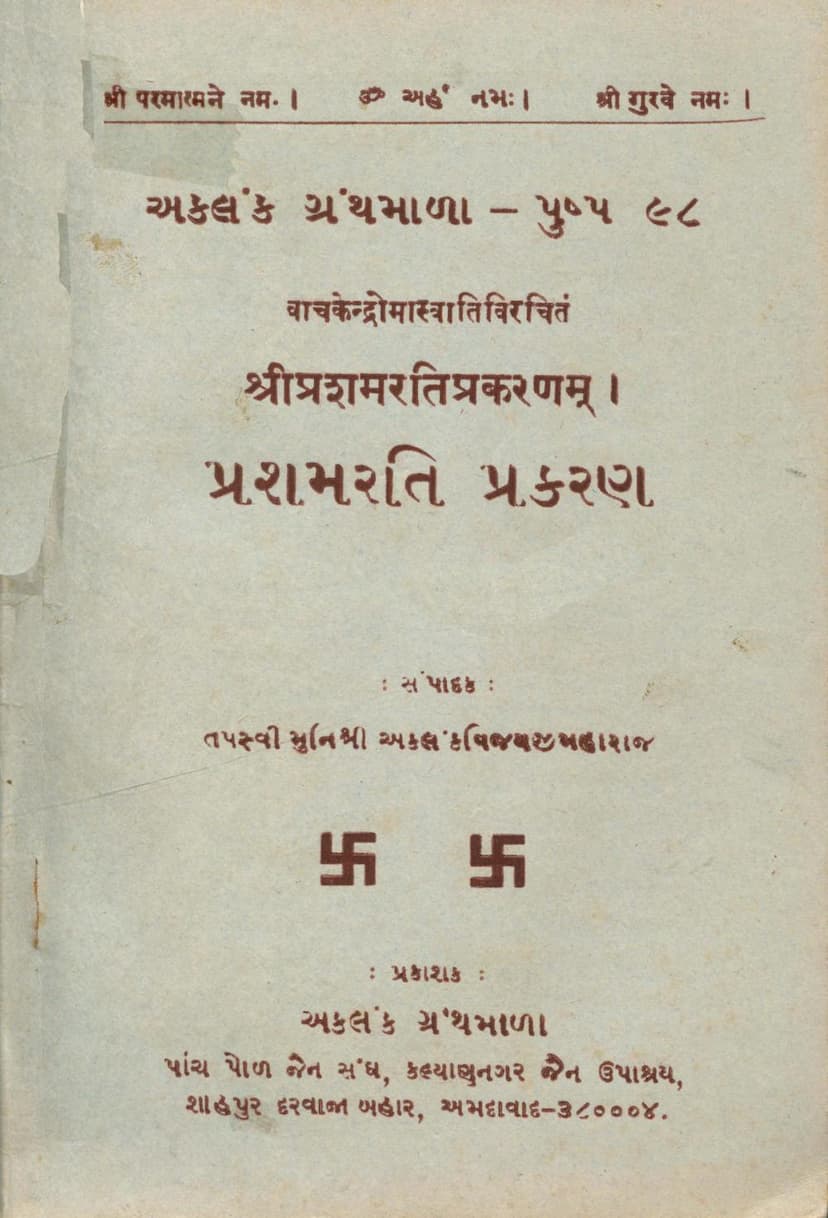Prashamrati Prakaran
Added to library: September 2, 2025

Summary
Here's a comprehensive summary of the Jain text "Prashamrati Prakaran" by Akalankvijay, based on the provided Gujarati text:
Book Title: Prashamrati Prakaran (પ્રશમરતિ પ્રકરણ) Author: Acharya Kundakunda (as indicated by "Vachakendra Um Swati Virachitam" which seems to be a misunderstanding as the introduction mentions Acharya Akalankvijayji as the editor and the text is attributed to Kundakunda in the title page. However, the core message is about achieving tranquility and peace, a central theme in Jain philosophy often associated with Acharya Kundakunda's teachings on detachment and spiritual discipline.) Publisher: Akalank Granthmala Catalog Link: https://jainqq.org/explore/022150/1
Summary:
The "Prashamrati Prakaran" (The Chapter on Tranquility) is a Jain scripture that delves deeply into the principles and practices for attaining inner peace, tranquility, and ultimately, liberation. Authored by the esteemed Jain scholar and editor, Tapasvi Muni Shri Akalankvijayji Maharaj, and published by Akalank Granthmala, this work aims to guide readers towards a life of detachment, righteousness, and spiritual advancement.
The text begins with auspicious invocations to the Tirthankaras, Siddhas, Acharyas, Upadhyayas, and all Sadhus, acknowledging their role as guides on the path to spiritual stability. The author then expresses his intention to present teachings from the Jain canon to foster "Prashamrati" – the cultivation of tranquility and peace in life.
Core Themes and Content:
The "Prashamrati Prakaran" systematically explores the roots of suffering and the path to its cessation, emphasizing the following key concepts:
- The Nature of Suffering (Dukha): The text extensively details how worldly attachments, particularly the four cardinal vices – Krodha (anger), Mana (pride), Maya (deceit), and Lobha (greed) – are the primary drivers of suffering and the cycle of birth and death (samsara). It illustrates how these vices corrupt perception, lead to misguided actions, and bind the soul with karmas.
- The Role of Karmas: The scripture explains the eight types of karmas (Jnanavaraniya, Darshanavaraniya, Vedaniya, Mohaniya, Ayushya, Nama, Gotra, and Antaraya) and their intricate mechanisms of bondage, manifestation, and ultimate shedding. It highlights how actions driven by passions lead to the accumulation of karmas, which perpetuate suffering.
- The Path of Renunciation and Tranquility (Vairagya & Prasham): The central theme revolves around the cultivation of detachment (vairagya) and tranquility (prasham). The text describes various synonyms for tranquility, including detachment, calmness, equanimity, and the victory over passions.
- Ethical Conduct and Spiritual Discipline: The book emphasizes the importance of righteous conduct, self-discipline, and adherence to Jain principles. It outlines practices such as:
- Control of the Senses (Indriya Nigraha): The text vividly describes how attachment to sensory pleasures (sound, touch, taste, smell, sight) leads to ruin, comparing the soul to a moth drawn to a flame. It stresses the need to control the senses to prevent being ensnared by worldly temptations.
- The Importance of Virtues: Virtues like forgiveness, humility, sincerity, contentment, and purity are highlighted as essential for spiritual progress. The text emphasizes that true beauty and respect come from inner qualities and virtuous conduct, not from external possessions or physical attributes.
- The Significance of Knowledge and Wisdom: The author underscores the need for scriptural knowledge (Shruta) and wisdom (Buddhi) to understand the true nature of reality and to navigate the path of liberation. It stresses the importance of humility and respect for the teachings of the omniscient Tirthankaras.
- The Power of Renunciation: The text advocates for renunciation of worldly attachments, including family, wealth, and sensual pleasures, as a direct path to freedom from suffering.
- The Practice of Meditation and Austerity (Dhyana & Tapa): Meditation and various forms of austerity are presented as crucial tools for purifying the soul and shedding karmas.
- The Cycle of Rebirth and Liberation: The book elaborates on the continuous cycle of birth, death, and rebirth driven by karmic influences. It clearly outlines the steps involved in achieving liberation (Moksha) by overcoming these karmic bonds through righteous conduct, knowledge, and spiritual practice.
- The Qualities of an Ideal Soul (Siddha): The text describes the state of a liberated soul, free from all karmas, dwelling in eternal bliss and omniscience. It explains the journey of the soul from the material world to the state of Siddhahood.
Author's Mission and the Publisher's Role:
The introductory pages highlight the extensive work of Muni Shri Akalankvijayji Maharaj in publishing numerous Jain scriptures. His mission is to spread religious knowledge through illustrative stories and biographies, making Jain teachings accessible to a wider audience. The Akalank Granthmala plays a vital role in this endeavor, facilitating the dissemination of these spiritual texts. The publisher also encourages contributions and patronage for their publication activities, recognizing the importance of spreading Jain knowledge.
Structure and Tone:
The "Prashamrati Prakaran" is written in a clear and didactic style, using eloquent language and numerous analogies from nature and everyday life to illustrate complex spiritual concepts. It aims to inspire readers to cultivate detachment, practice virtue, and strive for spiritual liberation. The text is structured to provide a systematic understanding of Jain philosophy, moving from the causes of suffering to the ultimate state of freedom.
In essence, "Prashamrati Prakaran" is a profound guide for anyone seeking inner peace and spiritual liberation within the framework of Jainism. It systematically deconstructs the roots of worldly suffering and provides a clear, actionable path towards a tranquil and enlightened existence, ultimately leading to the ultimate goal of Moksha.